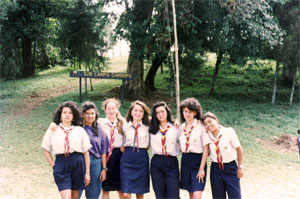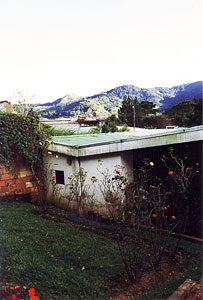 I'm in my late teens in this undated photo. I'm the third from left to right. It's very likely one of the last times I went camping as a member of the Girl Guide and Boy Scout Association of Costa Rica, which I joined when I was 11. I was very lucky growing up in Costa Rica because the association's national campground, called Campo Escuela Iztarú, where this photo was taken, was in the hills near my house. From the backyard of my childhood home in Tres Ríos, you can see the national campground. It's the hill in the background, dotted with a few trees. I thought a lot about this campground while I was working on our QUEST Nature Deficit Disorder TV segment about how kids nowadays in the United States aren't spending enough time out in nature.
I'm in my late teens in this undated photo. I'm the third from left to right. It's very likely one of the last times I went camping as a member of the Girl Guide and Boy Scout Association of Costa Rica, which I joined when I was 11. I was very lucky growing up in Costa Rica because the association's national campground, called Campo Escuela Iztarú, where this photo was taken, was in the hills near my house. From the backyard of my childhood home in Tres Ríos, you can see the national campground. It's the hill in the background, dotted with a few trees. I thought a lot about this campground while I was working on our QUEST Nature Deficit Disorder TV segment about how kids nowadays in the United States aren't spending enough time out in nature.
Every year, during the decade or so that I was a Girl Guide in Costa Rica, my fellow guides and I would trek up the steep hill, usually carrying our own sleeping bags and supplies. Once we got to the top, we chopped up wood with machetes and cooked over open fires. We woke up at the crack of dawn and showered in icy-cold water. During the rainy season, we got very wet. During the dry season, we got sunburned.
Camping took precedence over almost everything else. The day I graduated from high school I was in the middle of an international camping trip with girl guides from around the world. My parents drove up the hill, put some ointment on my sunburned ears and whizzed me over to the theater to pick up my diploma. Then they drove me back up the hill to finish the event.

campground ridge in the background
Our trips were always full of that sense of adventure you can only experience as a kid when you're out in nature and away from your parents. We ran up and down the mountains, crawled in muddy pits, climbed trees and cut ourselves with our machetes. By the end of our trips we were always completely worn out. Once, I sat on my bed and fell asleep with my backpack still on my back.
But all this happiness came to a crashing halt. On Aug. 20, 1988, when I was 16, a young couple my age was murdered in a coffee field on the road to the campground. My sister and I were supposed to go camping a few days later. But my parents wouldn't hear of it, no matter how much we begged. And who could blame them? The way he had killed his 14 victims was so cruel that it was impossible to incorporate his methods into his moniker, à la The Boston Strangler. So the press simply called him el psicópata, The Psychopath. Fear of el psicópata marked my adolescence and early adult life.